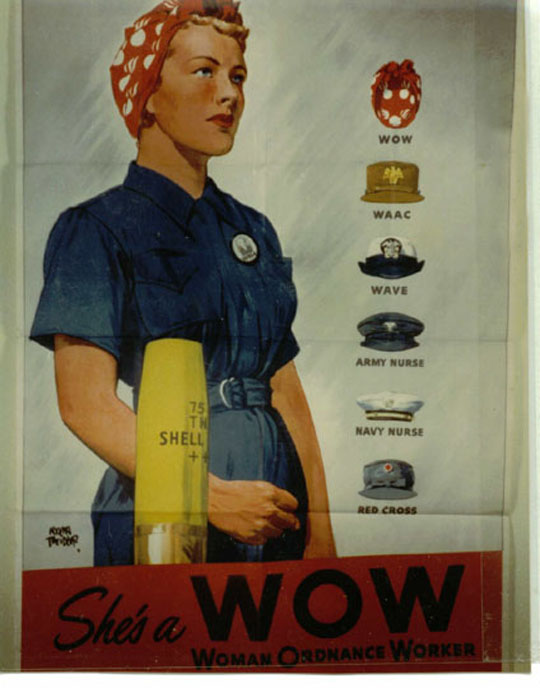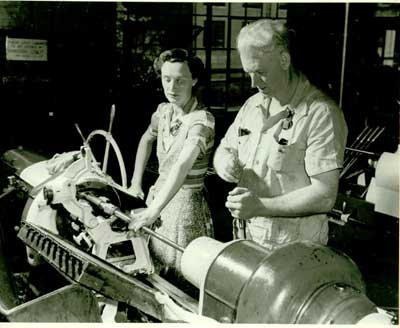|
The Armory was better prepared for war production in 1941 than it had been in 1917.
At the time of the Japanese attack on Pearl Harbor, the production quota of M1's
was 1,100 per day; by July 1943 it nearly doubled to 2,100 per day. At the same
time the workforce increased from 7,500 to 12-13,000. As in World War I, women
were hired to help overcome the labor shortage induced by the draft; they constituted
20% of the workers by June 1942 and 43% by June 1943. Despite this measure, the
workforce declined in number to 11,300-11,800 in the second half of 1943,
to 10,900 by June 1944, and to 9,400 by the end of 1944.

"She's a WOW (Woman Ordnance Worker)" with Rosie the Riveter
During World War II some three million women worked in war plants across the
United States. Working women were vital to the war effort, as the loss of men
to military service left a workforce shortage in many areas. The U.S. Government
undertook a major public relations campaign to encourage women to work. The use
of an invented character- "Rosie the Riveter" - on a brightly colored
poster was a powerful propaganda piece.
While some leaders only urged women to continue such traditional roles as
knitting, buying bonds, stretching rationed foodstuffs, and keeping up the nation's
morale, others on the home front challenged women to join the ever-growing ranks
of America's "production soldiers." In September 1942, Secretary of
War Henry L. Stimson made public his plan to double the number of women hired
in war jobs. Newspaper accounts of that time reported that since 1 June 1942
the number of skilled women workers in the War Department had risen from 3 percent
to 10 percent. Almost 35 percent of the department's unskilled workers were women.
Uncertainty about the willingness and ability of American housewives to assume
a larger defense role was expressed nationally as well as locally. One labor
analyst warned that, "The employment of millions of untrained workers, including
old men, youths, and housewives,...[would] inevitably result in a material and
gradual dilution of labor skills, which...[meant] a decline in manpower output." The
previously successful employment of women defense workers, according to this
same analyst, was "...attributable to the fact that the more experienced
and best adapted have naturally been the first employed. As...[the nation drew]
more and more upon inexperienced and untrained homemakers, the average efficiency
of women...[would] decline."

Woman operating chambering machine
Most of the women employed by the Army had to adjust not only to working outside
the home but had to accustom themselves to working under conditions that would
have tried the stamina and patience of experienced male industrial workers. In
addition, many of the women workers at both arsenals contributed what little
spare time they had to supporting a variety of home front activities such as
Red Cross work, war bond drives, and packaging special seasonal boxes for distribution
to soldiers overseas.
The pressures of work, the strain of trying to keep up with family obligations,
the stress of worrying about loved ones fighting in the war or being held prisoner
behind enemy lines, the lack of adequate rest and nutrition, even ill health
all contributed to higher levels of absenteeism among women workers. To keep
up the morale of all their workers, Army officials sponsored special after-hours
social events such as dances. Another was the September 29th, 1943, big band
concert by Benny Goodman and his “Spotlight Band” given to the employees
on the grounds near the Main Arsenal (housing the present-day Museum of Springfield
Armory National Historic Site). Special awards ceremonies were held so that employees
could be a part of the recognition given to the production successes enjoyed
by all workers.
|